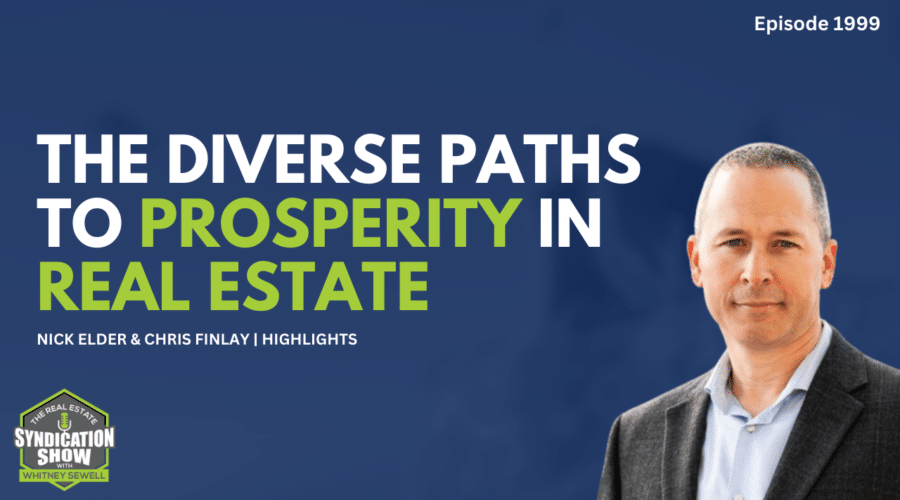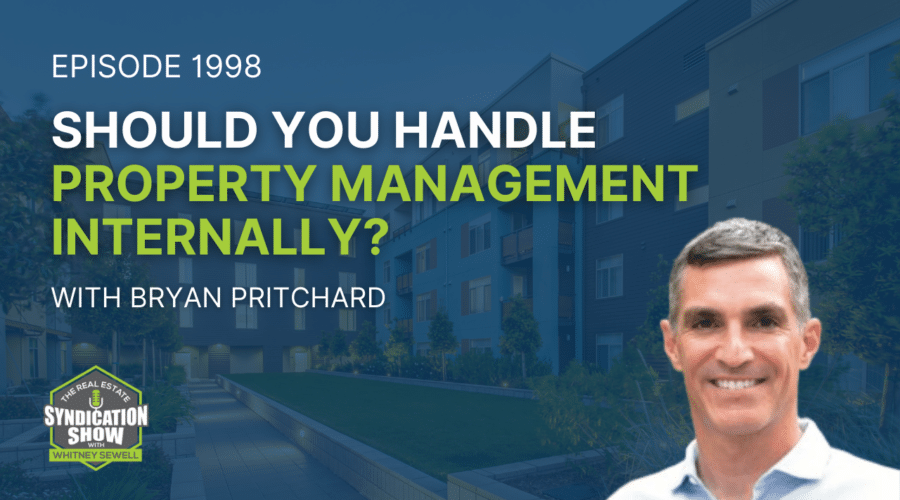Real estate is a big industry, that’s why it counts if you stand out from the rest. This is the advantage of having a value-add property, you get to offer more to your prospected tenants and at the same time have a chance of better earnings. In this episode, we look back at our conversations with Spencer Cullor of ApartmentVestor and Rich Trepanier of Gage Multifamily Services.
A Guide to Passively Investing in Commercial Real Estate
Get your free Copy of “A Guide to Passively Investing in Commercial Real Estate”. Inside you’ll learn the basics of passive income and real estate syndication, what kind of returns you can expect, how to find a sponsor and how to evaluate the risks. Download your copy in the show notes or visit lifebridgecapital.com/investbetter to start your investment journey.
Watch the episode here:
Listen to the podcast here:
Spencer and Rich both talk about how you can add value to your properties and in return earn more. Spencer talks about the steps he undertook to improve tenant quality in his multifamily properties. Meanwhile, Rich shares a detailed guide on what it takes to do a value-add renovation. Click the play button and find out how you can stand out in this industry with value-add properties!
Key Points From This Episode:
- Spencer shares his background and how he started in real estate.
- Learn how Spencer managed to improve tenant quality after extensive renovations on his recent acquisition.
- How Spencer enlisted the help of the community to improve asset quality.
- Is it normal to deal with bad tenant quality and vacancies in multifamily investing?
- Are Spencer’s investors wary of investing in deep value-add deals?
- Rich’s background, what he’s involved in, and why he only works on value-add projects.
- Find out what Rich’s definition of value-add is.
- Some of the most common pitfalls that Rich sees when working on a value-add project.
- How Rich breaks down his budget when working by square footage rather than by door.
Tweet This!
“We focus on three things – improve the property that we’re on, improve the community that we’re in, and improve our investors’ bottom line.” – Spencer Cullor
“It makes you feel really good when you see an area start to turn but it also improves your property value.” – Spencer Cullor
“Multifamily is a living, breathing, investment that you have to take care of every day.” – Spencer Cullor
“When an acquisition occurs, your groups of investors want to provide value. They want to add to the community, they want upgrades. So, they’re adding value through interior renovations, curb appeal, exterior renovations, exterior paint and carpentry, and landscaping.” – Rich Trepanier
“Adding value to the residents so that they can increase rents, but also provide a home to the residents.” – Rich Trepanier
Links Mentioned in Today’s Episode:
WS152: How to Add Value to Your Multifamily Investment with Spencer Cullor
WS506: What It Takes to Do a Multifamily Value-Add Renovation with Rich Trepanier
About Spencer Cullor
Real estate investor, business owner, author, speaker, and current President of Commercial Acquisitions, Spencer has developed an extensive background in commercial, multifamily, and residential real estate.
A graduate of the University of Kansas, Spencer received his Bachelor of Science degree in business administration with an emphasis in marketing and finance. With over twelve years’ experience in real estate, including asset management for multifamily, retail, and office properties, he has developed skills in acquisitions, financial analysis, and underwriting, due diligence, asset management, marketing, property management, raising private money, construction, and investor relations.
Spencer has been a featured speaker on the topic of multifamily investing for several business organizations including the Mid-America Real Estate Investment Group. Spencer has also been a featured author in publications such as Business Insiders, BiggerPockets, and Multifamily Insiders to name a few.
Spencer holds expertise in commercial, multifamily, and residential real estate. He also spent several years as a home builder. Using his skills in project management, raising private money, financial analysis, budgeting and accounting, construction, and contract management, he has successfully owned and managed multiple framing crews, has overseen numerous rehabilitations and flips of residential homes, multifamily properties, and started his own property management company specializing in multifamily and commercial properties.
In his first multifamily investment, he put together a private investment group to purchase, rehab, and improve the management to increase the value by over 75% and create a cash flow of over $8,000 per month in under 18 months. He has created over $5M in equity on multifamily investments in his first five years and grown a real estate portfolio to over $25 Million.
Spencer currently resides in Overland Park, KS with his wife Sarah and 18-month old daughter Collins and the family dog, Char. Spencer’s hobbies include cheering on the Jayhawks as an avid college football and basketball fan, playing golf, tennis, and basketball, traveling, and taking his daughter for long walks.
About Rich Trepanier
Rich Trepanier is the President and Co-Founder of Gage Multifamily Services, a Texas-based multifamily renovation general contractor.
With over 15 years year of multifamily renovation leadership experience, Rich has successfully produced over 1,200 multifamily renovation projects throughout the United States. With a special focus on working with investors during the acquisition phase of an asset, Gage Multifamily Services will partner with the acquisition team to provide our expertise and services to ensure proper budgeting, due diligence, and construction management of the value-add renovation.
Full Transcript
EPISODE 986
[INTRODUCTION]
0:00:00.0 ANNOUNCER Welcome to the Real Estate Syndication Show. Whether you are a seasoned investor or building a new real estate business, this is the show for you. Whitney Sewell talks to top experts in the business. Our goal is to help you master real estate syndication.
And now your host, Whitney Sewell.
0:00:24.0
Whitney Sewell
This is your daily real estate syndication show, I’m your host Whitney Sewell . So, this is your daily real estate syndication show. I’m your host and Whitney school. We hear the term all the time in our industry, value-add, the value-add real estate or value-add projects, and that term is turn around a lot. But there’s many different parts of a value-add business plan, and then we need to know about, especially if you are a passive investor or if you’re an operator, you need to think about, is this a deep value add? Is this is the light value add? how do we express that? How do we know what to do when we’re talking about a value-add type project?
We hope today you learn a lot from the highlights from these shows and these operators talking about value-add projects. Have a blessed day.
[INTERVIEW 1]
0:01:01.0
Whitney Sewell
Our guest is Spencer Cullor. Thanks for being on the show, Spencer.
0:01:05.0
Spencer Cullor
Thank you very much for having me.
0:01:07.0
WS: And I’m excited to have Spencer on the show. He is a multi-family expertise specializes in adding value to real estate investments. He’s now created over $10 million in equity in the last seven years. I grew up in a family rock quarry business, and after college help cure software business before we’re starting a real estate investment business with his father. Now it grows the business by putting together private investment groups where all can share in the success.
So, Spencer, thanks again for being on the show and look forward to diving in a little bit in your experience in just in real estate, how you agree to this equity and some challenging things you’re working on right now, what we discussed. But give the listeners a little more about just who you are and what your focus is now and how you got there?
0:01:47.0
SC: Sure, like you said, my name is Spencer Cullor. I’m the president of ApartmentVestors. We put together private investment groups to go buy an add value to multi-family investments. We kinda focus on three things, one, improving the property that we’re on in proving the community that we’re in, and then improving our investors bottom line.
So, those are kind of the things to drive us in our real estate investments and kind of why we really like multifamily investments.
0:02:19.0
WS: So, you said improving the property, and what was the second thing?
0:02:20.0
SC: Improving the communities that we’re in. By a lot of the times, we take on a challenge in asset that maybe has had problems for the city or problems for an area, and we really clean it up, we get the city involved to really improve the profile of that property. And then, we try to participate in the cities that we’re involved in. And then, improving our investors, bottom line, and we do all those things, so it’s kind of a three-pronged approach we take to every investment.
0:02:48.0
WS: No, I like that. I don’t hear people talk about the community very often. You and I talked a little bit about just solving challenging problems and you like to focus on that, which is great. It’s a good skill to have. Could you tell us about maybe a recent property or get us started a property where you had a recent challenge that you had to solve?
0:03:05.0
SC: We recently bought two properties and then one down the street from it in an area that are all within a block of each other. And after taking them over, we’ve figured out a little more about some challenging tenants. So, we’re living in the area on the property, and some challenges the area was having. So, one of the things we did was immediately, and we do this on most of our investments, we get involved with the local community, with the police department, the city, to try to see what we can do to help one, improve the property. And then with doing that, what can we do to help the area in general around.
And what we found with this is that one, we get a lot of satisfaction out of this, but it makes you feel really good when you see an area start to turn, but it also really improves your property value. Just rent start coming up all around you, you get your neighbors involved, they start raising rents as well. And then you can see profits really multiply when you do that. But if we had a property that had some hidden challenges on the physical side, so we did a physical renovation, we did exterior inter, and with that, we had to take the occupancy really low. Because we found out the previous ownership wasn’t doing screening, all those types of things, weren’t checking for criminal background, and they were just kind of filling the property with anybody that can, they could appear to be a certain occupancy. So, they could sell it.
So, one of the things we had to do before to bring in the tenant profile that we needed was to clear out some of those challenges and challenging tenants that would have been better suited living someplace else. And then do the renovations so that we could attract the right kind of tenants. But in this particular block, it’s in a really nice area all around it, but we had a one-block area that had had, at one point, here was an ownership group that came in there that owned for the properties, they let them all run down, it went into probate and some other things, and so this area developed kind of a bad reputation.
So, one of the things we did was get all of our neighbors involved, we formed a neighborhood community watch group, we shared resources with security officers and we shared band books and all kinds of information back and forth with those people. We also get the city involved to see what we could do from a grant standpoint to add more sidewalks to the area. What we could do? We got a lot of the foundations, churches around the area to help pitch in, and with that we’ve had seen really a resurgence of that area in the last six months where everybody’s kind of jump on board, even the ones that were skeptical at first. And you’re seeing everybody clean up their properties and start to do renovations and take pride in their properties, which is making the rents in the whole area go up. So, it will end up helping their property values too, but it will definitely help ours as well.
[INTERVIEW 2]
0:06:20.6
WS: Our guest is Rich Trepanier. Thanks for being on the show, Rich.
0:06:23.0
RT: Thanks for having me Whitney, I really appreciate it.
0:06:26.2
WS: Yeah, you’re a perfect desk, and I’m looking forward to this conversation and a little about Rich, he’s a founder of Gage Multifamily Services based in Austin, Texas. With over 30 years of multifamily renovation experience, they have successfully sold and produced over 2,000 multi-family renovation projects throughout the US.
Rich, thank you again for your time, give the listeners a little more about who you are, and let’s dive into this, this topic of renovation.
0:06:51.2
RT: Yeah, absolutely. So, you kind of summarized it pretty good there. My brother and I, Gage Multifamily Services based in Austin, Texas. We have offices in Austin, in San Antonio, the name says it all. We focus just on multifamily renovation, 100%, been doing it for about 15 years now in seven years as Gage, multifamily services where we decided to start our own business, we only do value add, we don’t do new construction, so a lot of your saline should be a lot of value of today.
0:07:19.3
WS: Okay. So, I guess first, why only value-add?
0:07:22.6
RT: You know, my brother and I, we… before we got to Austin, Texas, we lived in St. Louis for a little bit, and we get a lot of house renovation, but also dabbled in investments of twos and four families in St. Louis, got a lot out of that experience. We grew up with some construction experience and jumped in, did a lot of work ourselves, we saw a lot of value owning those twos and fours, we got to really see the appreciation from some of the residents that moved into those units after we were done. A lot of historic renovation of historic homes in St. Louis, and unfortunately, when 2008-2009 came, we had to hurry up and get some jobs. So, we saw the downgrade in the single-family home, but we saw the spring for the multifamily home, and shortly thereafter, I moved to Texas, as you know, multifamily is a large strength in Texas as well.
0:08:08.5
WS: Wow, so you’ve seen that multi-family was some stronger or that business model, I guess we could say.
0:08:13.7
RT: Yeah. No, it worked out really well.
0:08:15.9
WS: Could you just elaborate or just ensure what value-add is? We use that term all the time. I think most listeners have a good handle, however, it’s used about so many people, I just love to hear your definition.
0:08:29.0
RT: Absolutely, and so we’re in a perfect area between Austin and San Antonio, where you see a lot of different multifamilies transact between owners and sellers. And traditionally, as many of your listeners know, when an acquisition occurs, those new groups of investors want to provide value, they wanna add to the community, they wanna do upgrades. So, they’re adding value either through interior renovations, curb appeal, extra renovations, let’s just call an exterior paint and carpentry to landscaping. We do an awful lot of leasing office renovation, clubhouse renovation, fitness renovation, and so adding value to the residents so they can A, increase rents, but also provide a home to the residents.
0:09:11.1
WS: So, there’s so many pitfalls in trying to do value-add multifamily. And I thought, with your level of experience, I’d love for you to highlight some of those. Let’s dig in a little bit.
0:09:20.5
RT: Yeah, so we often deal with investors. Our goal as a business is to get to the decision makers who are acquiring these communities and get to them earlier enough where we can help them plan their CAPEX budgeting. And so, some of the pitfalls that we see is, is oftentimes, one of my big things that I’m always cringe a little bit is that you hear people budget their CAPEX by doors, and I’m a big proponent on those interior renovations, doing it based on square footage and the reason is very simple. You have $5,000 a door, that number works really well for a one-bedroom, one bath, 700 square foot unit, but that doesn’t translate very well to a three-bedroom, two-bath, 1,200 square foot unit. And if you have $5,000, it just doesn’t go very well. $5,000 might get you flooring and paint, but it won’t get you that granite counter tops, those new fixtures, those new faucets. So, what I like to do, and when I meet with our investors that we work with, I like to tell them to, Let’s look at it from a square footage standpoint, that your money can go the farthest and that you can accomplish your business plan, which is let’s renovate 72 units, let’s renovate a 150 units. You’re taking it throughout the entire business plan.
Another one I see quite a bit of is no one provides contingency against that $5,000 per door budget, and so add a little bit of contingency on there, a little bit of whoops factor, a little bit of something will happen on my own business, the construction side of Gage Multifamily services, we always add in between three to five percent contingency on our bid to our customers, and that helps us kind of alleviate any issues that we might see, that we might not see during the budgeting process.
And the other important one for everyone to remember another really good pitfall is who manages the renovation process, the renovation project, is it gonna be your asset manager, is it gonna be the person with your boots on your ground in the city that you’re not located in, is it gonna be your property manager? Property managers traditionally charge in between 5% and 7% roughly to energy renovation project from start to finish, and that 5% to 7% is calculated based on the gross expenses for the renovation project.
0:11:29.5
WS: Wow, some great topics there or these pitfalls, and it’s interesting talking about budgeting their CAPEX by door, it’s the way I see it all the time as well. But it’s interesting how you say, we should break that down by square footage, and could you just give us a couple of tips and breaking that down like that, or maybe how you go through that process.
0:11:47.4
RT: Sure, for instance, a lot of times we see CAPEX into your renovation, but everyone wants to replace the flooring. So, a good rule of thumb for me, and when we buffering is usually $2 per square foot to take up and put down brand new flooring. We often see on a same level renovation project, we also see resurfacing a counter top sections about a good dollar value there is, is $150 to resurface your kitchen counter tops and then usually between $50 and $60 for your vanity counter tops as well. We usually, a good budget value or into your paint for square footage is right around a dollar traditionally is where we usually play per square footage for the unit space, so we can go even further, we can talk about pictures and plumbing fixtures, it just depends on what class level the renovation project is. And then how far you wanna go, usually for first-time investors who usually contact me, I usually tell them let’s stick on a peg into your renovation for apartment community, usually runs about $5 and 50 cents a square foot, and that would traditionally get you new flooring into your paint resurfacing or counter tops, maybe a picture or two, but it’s really what it describes looking, you’re getting in there, you’re renovated unit quickly and trying to get residents back into the unit very fast.
00:13:02.0
Whitney Sewell: We hope that you enjoyed the Highlights show today. You can always listen to the full episodes that were featured today by clicking the links in the show notes page. And in the description box, let us know why what you’ve thought of this episode or you can go to lifebreidgecapital.com/podcast and click the feedback button. Let us know how we can add value to you. Thank you and talk to you tomorrow.
00:13:26.000
ANNOUNCER: Thank you for listening to the Real Estate Syndication Show, brought to you by Life Bridge Capital. Life Bridge Capital works with investors nationwide to invest in real estate while also donating 50% of its profits to assist parents who are committing to adoption. Life Bridge Capital, making a difference one investor and one child at a time. Connect online at www.LifeBridgeCapital.com for free material and videos to further your success.
[END]
Love the show? Subscribe, rate, review, and share!
Join the Real Estate Syndication Show Community:







